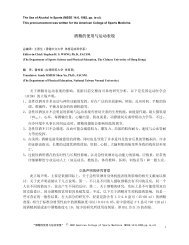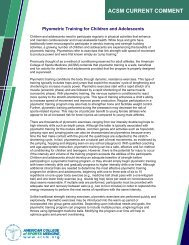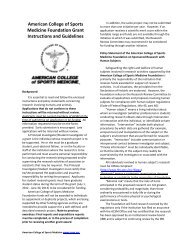Selecting and Effectively Using Hydration for Fitness - American ...
Selecting and Effectively Using Hydration for Fitness - American ...
Selecting and Effectively Using Hydration for Fitness - American ...
Create successful ePaper yourself
Turn your PDF publications into a flip-book with our unique Google optimized e-Paper software.
ACSM In<strong>for</strong>mation On…<strong>Selecting</strong> <strong>and</strong> <strong>Effectively</strong> <strong>Using</strong><strong>Hydration</strong> <strong>for</strong> <strong>Fitness</strong>Water is the most essential component of the human body as it provides an important role in the function of cells. Important functions of waterinclude transportation of nutrients, elimination of waste products, regulation <strong>and</strong> maintenance of body temperature through sweating,maintenance of blood circulation <strong>and</strong> pressure, lubrication of joints <strong>and</strong> body tissues, <strong>and</strong> facilitation of digestion. More than half of the humanbody is composed of water, <strong>and</strong> it is impossible to sustain life without it.A COMPLETE PHYSICAL ACTIVITY PROGRAMA well-rounded physical activity program includesaerobic exercise <strong>and</strong> strength training exercise, butnot necessarily in the same session. This blend helpsmaintain or improve cardiorespiratory <strong>and</strong> muscularfitness <strong>and</strong> overall health <strong>and</strong> function. Regularphysical activity will provide more health benefits thansporadic, high intensity workouts, so chooseexercises you are likely to enjoy <strong>and</strong> that you canincorporate into your schedule.ACSM’s physical activity recommendations <strong>for</strong> healthyadults, updated in 2011, recommend at least 30minutes of moderate-intensity physical activity(working hard enough to break a sweat, but still ableto carry on a conversation) five days per week, or 20minutes of more vigorous activity three days perweek. Combinations of moderate- <strong>and</strong> vigorousintensityactivity can be per<strong>for</strong>med to meet thisrecommendation.Examples of typical aerobic exercises are:• Walking• Running• Stair climbing• Cycling• Rowing• Cross country skiing• Swimming.In addition, strength training should be per<strong>for</strong>med aminimum of two days each week, with 8-12repetitions of 8-10 different exercises that target allmajor muscle groups. This type of training can beaccomplished using body weight, resistance b<strong>and</strong>s,free weights, medicine balls or weight machines.WATER LOSSExercise produces an elevation in bodytemperature, which depends on theintensity <strong>and</strong> duration of exercise,environmental conditions, clothing worn,<strong>and</strong> metabolic rate. In order to get rid ofthe excess heat, your body secretessweat, which is primarily composed ofwater <strong>and</strong> electrolytes such as sodium.The evaporation of sweat is the primarymechanism of heat loss during exercise.Exercise can lead to substantial water <strong>and</strong>electrolyte loss from sweat leading todehydration <strong>and</strong>, in cases of excessivefluid intake, hyponatremia (low sodium inthe blood). However, considerablevariability exists from person to personwith regard to sweat loss. There<strong>for</strong>e, thefluid <strong>and</strong> electrolyte requirements needed<strong>for</strong> the athlete are variable from person toperson as well. If water <strong>and</strong> electrolytesare not replaced from these losses, theathlete will have a decrease inper<strong>for</strong>mance <strong>and</strong> perhaps an adverseeffect on his or her overall health.FLUID BALANCEThirst is a signal that your body is headedtoward dehydration. There<strong>for</strong>e, it isimportant to drink be<strong>for</strong>e you feel thirsty<strong>and</strong> to drink throughout the day. Thirst isnot a good indicator of hydration <strong>and</strong>should not be used to monitor hydrationstatus.One way to check your hydration status isto weigh yourself be<strong>for</strong>e <strong>and</strong> after exercise.The be<strong>for</strong>e-exercise measurement is bestas a nude weight first thing in the morningafter urinating. Comparing your bodyweight be<strong>for</strong>e <strong>and</strong> after exercise can beused to estimate your sweat loss <strong>and</strong> yourfluid requirements. Any weight loss is likelyfrom fluid loss, so drinking enough toreplenish these losses will maintainhydration. The table below shows us thatover a one percent loss in body weightindicates dehydration <strong>and</strong> over five percentindicates serious dehydration. These fluidlosses need to be replaced.% Body Weight ChangeWell Hydrated -1 to +1%Minimal Dehydration -1 to -3%Significant Dehydration -3 to -5%Serious Dehydration > -5%
Another way to check hydration status isthe urine color test. A large amount oflight-colored urine means you are wellhydrated. The darker the color, the moredehydrated you are.12345678DEHYDRATIONDehydration is the loss of fluids <strong>and</strong> saltsessential to maintain normal bodyfunction. Dehydration occurs when thebody loses more fluids than it takes in.Dehydration can lead to:• Muscle fatigue• Loss of coordination• Inability to regulate body temperature• Heat illness (e.g., cramps, heatexhaustion, heat stroke)• Decreased energy <strong>and</strong> athleticper<strong>for</strong>manceModerate caffeine intake does not affecthydration status or urine output. However,alcohol will increase your urine output <strong>and</strong>decrease hydration.Enhancing palatability of a fluid will help toencourage fluid consumption. This can bedone with proper flavoring, proper salt(sodium) content <strong>and</strong> drinking a coldbeverage (15-21 degrees Celsius).SPORTS BEVERAGESCarbohydrates within a sports beveragehelp to replenish your sugar (glycogen)stores <strong>and</strong> electrolytes help to acceleraterehydration. Sports beverages <strong>for</strong> useduring prolonged exercise shouldgenerally contain four to eight percentcarbohydrate, 20-30 meq/L of sodium, <strong>and</strong>2-5 meq/L of potassium. The need <strong>for</strong>carbohydrates <strong>and</strong> electrolytes withinsports beverages increases withprolonged activity.Carbohydrate consumption helps tosustain <strong>and</strong> improve exercise per<strong>for</strong>manceduring high-intensity exercise longer thanone hour as well as lower-intensityexercise <strong>for</strong> longer periods. You shouldingest one-half to one liter of a sportsdrink each hour to maintain hydration.Also, sports drinks should not exceed acarbohydrate concentration of eightpercent.HYDRATION BEFORE EXERCISECheck your hydration status be<strong>for</strong>eexercise because there is a widevariability in fluid needs <strong>for</strong> each person.• Drink 16-20 fluid ounces of water orsports beverage at least four hoursbe<strong>for</strong>e exercise.• Drink 8-12 fluid ounces of water 10-15minutes be<strong>for</strong>e exercise.Consuming a beverage with sodium (salt)<strong>and</strong>/or small meal helps to stimulate thirst<strong>and</strong> retain fluids.HYDRATION DURING EXERCISE• Drink 3-8 fluid ounces of water every 15-20 minutes when exercising <strong>for</strong> less than60 minutes.• Drink 3-8 fluid ounces of a sportsbeverage (5-8 percent carbohydrate withelectrolytes) every 15-20 minutes whenexercising greater than 60 minutes.Do not drink more than one quart/hourduring exercise.HYDRATION GUIDELINES AFTEREXERCISEObtain your body weight <strong>and</strong> check yoururine to estimate your fluid losses. Thegoal is to correct your losses within twohours after exercise.• Drink 20-24 fluid ounces of water orsports beverage <strong>for</strong> every one poundlostOVERHYDRATIONOverhydration, also called waterintoxication, is a condition where the bodycontains too much water. This can result inbehavioral changes, confusion,drowsiness, nausea/vomiting, weight gain,muscle cramps, weakness/paralysis <strong>and</strong>risk of death.In general, overhydration is treated bylimiting your fluid intake <strong>and</strong> increasingthe salt (sodium) that you consume. Ifoverhydration is suspected, you shouldsee your doctor <strong>for</strong> appropriate lab tests<strong>and</strong> treatment. You should not consumemore than one liter per hour of fluid.STAYING ACTIVE PAYS OFF!Those who are physically active tend to live longer,healthier lives. Research shows that moderatephysical activity – such as 30 minutes a day of briskwalking – significantly contributes to longevity. Even aperson with risk factors like high blood pressure,diabetes or even a smoking habit can gain realbenefits from incorporating regular physical activityinto their daily life.As many dieters have found, exercise can help youstay on a diet <strong>and</strong> lose weight. What’s more – regularexercise can help lower blood pressure, control bloodsugar, improve cholesterol levels <strong>and</strong> build stronger,denser bones.THE FIRST STEPBe<strong>for</strong>e you begin an exercise program, take a fitnesstest, or substantially increase your level of activity,make sure to answer the following questions. Thisphysical activity readiness questionnaire (PAR-Q) willhelp determine if you’re ready to begin an exerciseroutine or program.• Has your doctor ever said that you have a heartcondition or that you should participate in physicalactivity only as recommended by a doctor?• Do you feel pain in your chest during physicalactivity?• In the past month, have you had chest pain whenyou were not doing physical activity?• Do you lose your balance from dizziness? Do youever lose consciousness?• Do you have a bone or joint problem that could bemade worse by a change in your physical activity?• Is your doctor currently prescribing drugs <strong>for</strong> yourblood pressure or a heart condition?• Do you know of any reason you should notparticipate in physical activity?If you answered yes to one or more questions, if youare over 40 years of age <strong>and</strong> have recently beeninactive, or if you are concerned about your health,consult a physician be<strong>for</strong>e taking a fitness test orsubstantially increasing your physical activity. If youanswered no to each question, then it’s likely that youcan safely begin exercising.PRIOR TO EXERCISEPrior to beginning any exercise program, including theactivities depicted in this brochure, individuals shouldseek medical evaluation <strong>and</strong> clearance to engage inactivity. Not all exercise programs are suitable <strong>for</strong>everyone, <strong>and</strong> some programs may result in injury.Activities should be carried out at a pace that iscom<strong>for</strong>table <strong>for</strong> the user. Users should discontinueparticipation in any exercise activity that causes painor discom<strong>for</strong>t. In such event, medical consultationshould be immediately obtained.This brochure was created <strong>and</strong> updated by Michael R. Simpson, D.O., M.S., <strong>and</strong> Tom Howard M.D. ACSM grants permission to reproduce this brochure, if it is reproduced in itsentirety without alteration. The text may be reproduced in another publication if it is used in its entirety without alteration <strong>and</strong> the following statement added: Reprinted withpermission of the <strong>American</strong> College of Sports Medicine. Copyright © 2011 <strong>American</strong> College of Sports Medicine. This brochure is a product of ACSM’s Consumer In<strong>for</strong>mationCommittee.
















